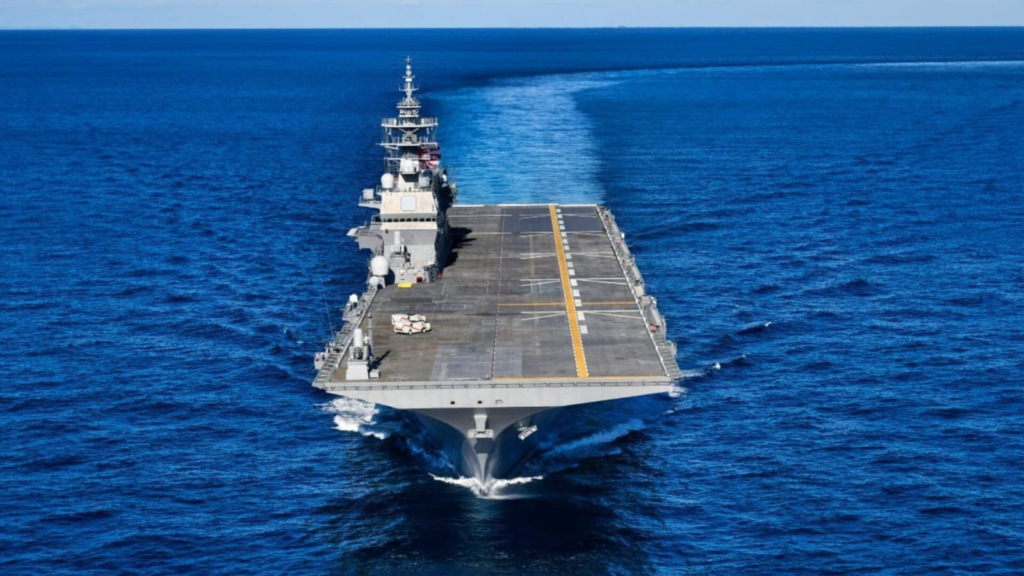Japan has recently deployed its largest warship, the JS Izumo, often referred to as an “aircraft carrier,” to the United States for joint military exercises aimed at enhancing defense cooperation and readiness between the two nations. This deployment marks a significant step in Japan’s evolving defense posture as it seeks to bolster its military capabilities amid growing regional tensions and threats.
The JS Izumo is classified as a helicopter destroyer but has been modified to operate as an aircraft carrier, capable of deploying F-35 stealth fighters. This capability is a crucial development for Japan’s Self-Defense Forces (JSDF), as the country aims to strengthen its air defense and enhance its ability to respond to potential conflicts in the Asia-Pacific region. With the recent acquisition of the F-35, Japan is committed to modernizing its military and aligning its capabilities with those of the United States.
During its visit to the U.S., the JS Izumo will participate in a series of war training exercises alongside the U.S. Navy, showcasing the interoperability of their forces. The training will involve various operations, including flight operations with the F-35s, anti-submarine warfare drills, and humanitarian assistance scenarios. This collaboration is essential for improving coordination and strengthening the military relationship between Japan and the U.S., which has been a cornerstone of security in the Asia-Pacific region since World War II.
The deployment of the JS Izumo comes at a time of heightened geopolitical tensions, particularly with North Korea’s increasing missile tests and China’s assertive military posture in the South China Sea and Taiwan Strait. Japan has expressed concerns over these developments and is taking proactive measures to enhance its defensive capabilities. The JS Izumo’s participation in joint exercises with the U.S. Navy signals Japan’s commitment to maintaining regional stability and deterring potential threats.
Moreover, this move reflects Japan’s broader strategy to play a more significant role in collective security initiatives. Japan’s government has been advocating for increased defense spending and a more assertive military posture, allowing the Self-Defense Forces to participate in international operations. The U.S.-Japan alliance has been crucial in addressing shared security challenges, and this latest development underscores the importance of joint military readiness.
The JS Izumo’s capability to operate F-35s marks a significant shift in Japan’s defense strategy. The F-35, known for its advanced stealth technology and combat capabilities, will enhance Japan’s air power and allow for greater flexibility in responding to regional threats. The integration of these aircraft into the JSDF signifies Japan’s commitment to modernizing its military and adapting to the changing security environment in the Asia-Pacific.
Furthermore, the deployment of the JS Izumo serves as a demonstration of Japan’s intent to engage in more extensive international defense cooperation. By participating in joint exercises with the U.S. and other allies, Japan aims to strengthen its partnerships and build a collective defense framework capable of addressing evolving security challenges.
As Japan continues to navigate a complex security landscape, the deployment of the JS Izumo to the U.S. for war training symbolizes a critical step in its defense strategy. By enhancing its military capabilities and reinforcing its alliance with the United States, Japan is positioning itself to better respond to potential threats and contribute to regional stability.
In conclusion, Japan’s deployment of the JS Izumo, equipped with F-35 fighters, for joint military exercises with the U.S. represents a significant evolution in its defense posture. This move not only highlights Japan’s commitment to enhancing its military capabilities but also reinforces the importance of the U.S.-Japan alliance in addressing shared security challenges. As geopolitical tensions continue to rise, Japan’s proactive approach to defense cooperation will play a vital role in ensuring peace and stability in the Asia-Pacific region.
